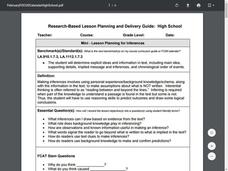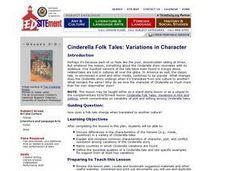Teacher Web
Inferring Character Traits
Learning how to draw inferences from text is a key reading comprehension skill. Here's a learning exercise that gives readers a chance to practice by offering 20 descriptive sentences and asking kids to identify the inferred character...
Curated OER
Inferring Character Traits
Here is a lesson plan which is "flexible," and can operate as an individual or whole class activity. After reading a book of their choosing, with the use of a semantic map, learners identify character traits. They infer how their...
Curriculum Corner
Inferencing
Inferencing is a necessary reading skill to uncover non-explicit messages in text. Use the set of resources as a way to guide learners toward becoming expert inferrers through reading prompts and literature with text and without text.
2012 Teaching Resources
Analyzing Character Traits
Character analysis becomes easy with a 24-page packet packed with mini-lessons, graphic organizers, and activities. A must-have for your curriculum library.
Curated OER
Mini-Lesson Planning for Inferences
Making inferences and drawing conclusions is a key component to successful active reading. Encourage your class to use context clues and prior knowledge to infer different elements of a story, including the setting, plot, and character...
Curated OER
Cinderella Folk Tales: Variations in Character
Students read a variety of Cinderella tales from different cultures. They discuss the differences in character, plot, and conflict resolution in the stories from different countries.
Curated OER
Build Mastery: Making Inferences
Do your youngsters realize that they are constantly making inferences? Expose this inner process by bringing out the book they will be reading. Ask scholars what they think the plan is, and explain that their answers are the product of...
Polk Bros Foundation
I Can Infer Motive and Effects for an Action
Help your pupils determine just what makes a character or person tick by zooming in on one character or person. This graphic organizer is dedicated to analyzing one person and asks pupils to infer a personality trait, note down an action...
Curated OER
Gus and Grandpa and the Two Wheeled Bike: comprehension skills
What a fantastic idea! Give these bookmarks to your readers to help them conquer pages 206-222 of Gus and Grandpa and the Two Wheeled Bike. They make inferences, conduct close reads, search for cause and effects, and focus on Gus, the...
Curated OER
Taming of the Shrew, Act 4.3, Study Questions
Shakespeare can be a challenge to the most skilled high school readers. This selection of short answer questions helps increase understanding of the character, Katherine, by addressing dialogue, tone of voice, making inferences, and...
Curated OER
The Miracle of the First Poinsettia
Connecting to literature and learning how to infer are two great reading strategies everyone needs to know. Here, the class will read along with the story The Miracle of the First Poinsettia, review folktales as a genre, and make...
Curated OER
The True Confessions of Charlotte Doyle: Graphic Organizer
After completing the first five chapters of The True Confessions of Charlotte Doyle By Avi, use direct quotes to make inferences about how Charlotte feels about certain characters. Later, when the novel has concluded, revisit the text to...
August House
The Great Smelly, Slobbery, Small-Tooth Dog
Read the story The Great Smelly, Slobbery, Small-Tooth Dog: A Folktale from Great Britain by Margaret Read MacDonald and choose from multiple activities to learn about the tale's theme—kindness. With so many options, your kind kids will...
Teacher's Corner
Is There a Wocket in my Pocket?
Accompany Dr. Seuss' Is There a Wocket in my Pocket? with this graphic organizer. Young readers make inferences about why the main character has certain feelings towards the creatures found in the story.
EngageNY
Writing, Critique, and Revising: Two-Voice Poems (Chapter 14: "Las Ucas/Grapes")
Continue work on the two-piece poem that compares two characters from Esperanza Rising. Give class members a few minutes to finish their drafts. After they have a complete product, model how to critique and edit the poems with one group....
Prestwick House
Analyzing Multiple Interpretations of Literature
There is a reason why an Oscar is given each year for the Best Adaptation Screenplay. Adaptations are the focus of an exercise that asks class members to compare a work of literature with a least one adaptation of the work into a...
Reed Novel Studies
Jacob Have I Loved: Novel Study
Twins always have double the fun, right? Sara, in Jacob Have I Loved, always is in the shadows of her twin sister. Scholars identify synonyms, answer comprehension questions, foreshadow, and create alliterations as they read about how...
Reed Novel Studies
Fourth Grade Rats: Novel Study
Things sure change in year's time. Suds, from Fourth Grade Rats, went from a third grade angel to a fourth grade rat! Although he is not necessarily happy with his new self, he worries he will lose his popularity. Learners complete...
Curated OER
Colors, Characters, & Clues: White Socks
Students examine the process of making inferences. They define inference, view a Powerpoint presentation, and as a whole group locate clues in the pictures of a short story, locating written clues to reinforce their conclusions.
Curated OER
CHARACTER DEVELOPMENT: EXAMINE EXPRESSIONS THROUGH PORTRAITURE
Students use a work or art as a springboard to a personal narrative or descriptive writing, create a collage to identify tone through art, and use inference to discern what might have caused an individual to feel the emotion that is...
Curated OER
LETTER FROM ONE CHARACTER TO ANOTHER
Fourth graders read stories and pick one with characters they find interesting. Then students create a dialogue of writing a letter from one character to another. The letter must relate to the original story in some way that can easily...
Pennsylvania Department of Education
Analyzing Literary Elements in Fiction
Students analyze the characters and events in fictional writing. In this literary elements instructional activity, students study the meaning of the words characterization and fiction. They listen to the story Pigsty by Mark Teague, or...
Curated OER
Unsent Letter: Characterization in Briar Rose
After completing Jane Yolen’s Briar Rose, class members assume the voice of Gemma and craft a personal letter to her granddaughter telling Becca how she feels about Becca’s actions and the discoveries at Chelmno. Complete directions for...
Reed Novel Studies
Escape From Mr. Lemoncello's Library: Novel Study
Comparing yourself to others is a sure way to make you feel worse about yourself. Kyle, a character in Escape From Mr. Lemoncello's Library, knows this well, as it is difficult for him to compete with his older brothers. Will he finally...























